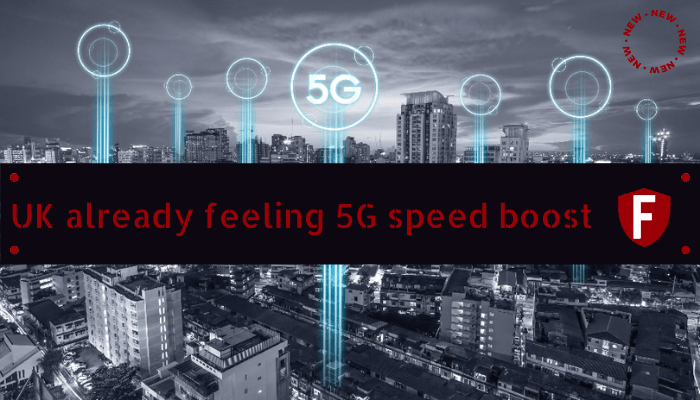The UK operators were racing to roll out 5G throughout last year and the resulting speed boost can be felt around the country
Leading mobile network benchmarking firm Global Wireless Solutions (GWS) has today released the results of its latest nationwide drive test assessing mobile network performance of the four major operators.
The latest national test – the first conducted by GWS which incorporates 5G network performance into the company’s OneScore rankings – reveals that good progress is being made in the deployment of 5G throughout the UK by EE, O2, Three and Vodafone. Based on network scanner testing, 5G is now available across 37% of the markets driven; in addition, throughput testing shows average speeds boosted nearly five times in areas where 5G is available.
5G: Covering the bases
The performance test results paint a clear picture of progress for the ongoing deployment of 5G across the UK. In particular, the data highlights how once a market reaches a certain level of 5G coverage, average network speeds are significantly boosted. Average speeds during network capacity stress tests where 5G is delivered are 150 Mbps across all operators, compared with 33 Mbps in areas where there is no 5G present.
Further, GWS also analysed the test results to determine what level of 5G coverage across an entire market (city or town) is needed to achieve a certain minimum threshold of speed for that market. GWS discovered that in order to achieve a baseline of 100 Mbps average network speed throughout an entire market, operators must first achieve around 40% coverage in that market (for consumers, 100 Mbps means that downloading a HD movie should take around two minutes).
GWS found that this baseline occurred in only 7 out of the 32 cities and towns tested (and in each instance only one operator in each city reached the baseline). In particular, Belfast, Birmingham, Cardiff, Glasgow, Liverpool, London and Manchester recorded average overall speeds in excess of 100 Mbps on any operator, with Vodafone accounting for four of these values and EE for three. And as 5G coverage expands, faster speeds are more likely to be consistently achieved. For example, in Belfast, EE achieved overall speeds of 102 Mbps with 5G coverage of 41%, whereas in Manchester, Vodafone recorded an average overall throughput of 166 Mbps with coverage of 70%.
In addition to achievements in speed, testing revealed that success rates for tasks completed with 5G were well over 99% across all operators.
5G: Running different races
According to analysis of GWS’s device and scanner tests, tasks completed on devices via 5G tends only to occur in areas with strong 5G signal, rather than everywhere it is available (relying instead on 4G). While 5G signal is available across more than a third (37%) of the markets tested by GWS, results show that it is only being delivered to 5G-enabled handsets one fifth (20%) of the time.
Even when 5G is available, it is clear from the data that each operator is approaching its deployment strategy differently. In particular, operators are focusing on deploying 5G at different locations and with varying percentages of 5G per city, town or motorway. Further, Vodafone’s network was completing tasks on 5G roughly three quarters of the time 5G signal was available, while the others were completing tasks on 5G around half the time.
Throughout testing, GWS found that 5G signal is, on average, available 40% of the time in UK cities, 16% in towns, and 11% on motorways, while at the same time the network is completing tasks on 5G just 23% of the time in cities, 8% in towns, and only 5% of the time along motorways. In fact, deployment of 5G along UK motorways appears to be progressing more slowly, with operators placing less emphasis on rolling out coverage along the nation’s highways. While full 5G will likely be required for enabling advanced applications of the future such as autonomous vehicles, today’s network needs on motorways are more limited and can be facilitated by existing network technologies.
Reliability of existing networks still paramount
While the deployment of 5G is resulting in the delivery of faster speeds, it’s still more important than ever (i.e., during this work from home period) for mobile operators to provide robust, reliable service. In terms of overall network reliability, O2 earns the title of the UK’s Most Reliable Network for the third year running, ranking top in 18 out of 37 locations tested in the UK according to GWS’s latest OneScore network reliability testing. O2 is also the most reliable on the UK’s major motorways, M1, M6, M25 and M62. It is followed in the overall rankings by EE which has wins in 16 locations. Vodafone has wins in 3 locations while Three has no wins.
These findings are borne out by GWS’s consumer survey, which found that even during the lockdown 39% of O2 customers were always satisfied with their network’s reliability, compared to 33% of EE customers, 31% of Vodafone customers and 30% of Three customers.
When looking at the regional rankings (which combine the results from all operators), for the second year running the best UK city for reliability remains Liverpool, with Nottingham now the least reliable.
Good news for consumers in lockdown
The results are encouraging for consumers currently navigating the ongoing pandemic – especially since the need to have acceptable speeds is crucial for home workers. With consumers likely to switch to their mobile network when poor WiFi fails them, it’s encouraging to see that 84% of O2 customers are happy with their speeds at home, as are 78% of EE customers, and 82% of Three and Vodafone customers. As 5G continues to roll out across the UK, consumers can look forward to marked improvements in speeds.
Consumers also have high expectations about the rollout of 5G, with 38% believing that faster 5G deployment could help improve economic recovery after the pandemic. Additionally, 26% believe that it could help fix the problem of the digital divide around the country.
Dr Paul Carter, CEO, Global Wireless Solutions, commented: “As next-generation technology is added into the network at more locations with overall speeds increasing and as new, feature-rich devices are introduced, customer expectations about network reliability remain constant – they want a network that they can rely on that will deliver the services they need.
“The results of our latest national testing show signs of good things to come for those with 5G-enabled phones across the country. Deploying a network nationwide isn’t instantaneous and each of the operators will face their own independent challenges. While we’ve seen significant improvements in speeds due to 5G, to realise predictable 5G coverage across entire cities and other locations, it’s simply going to take time.”





